What Is an Inflatable Life Jacket?

An inflatable life jacket is an emergency escape device designed for water-related accidents.
While lifeboats and life rafts are intended for the evacuation of multiple individuals, inflatable life jackets primarily aim to protect individual lives. These life jackets come in various forms, including inflatable waist belts, shoulder-worn (vest) types, and fixed designs. Wearing them helps mitigate the risk of drowning.
The use of life jackets is mandated in many countries, and in Japan, as of February 2018, all occupants of small vessels must wear inflatable life jackets.
Uses of Inflatable Life Jacket
Inflatable life jackets play a crucial role in ensuring safety on the water. They are utilized during boat or ship boarding, marine sports, water-related work, and recreational activities along water bodies.
Moreover, the inflatable design allows for convenient storage when not in use, making them valuable for vessels, airplanes, and other confined spaces. Serving as vital tools to protect lives during water accidents or disasters, inflatable life jackets find wide application in various scenarios.
Principle of Inflatable Life Jacket
The principle behind inflatable life jackets involves a gas cylinder integrated into the jacket’s back or chest. Pulling a cord or water sensing triggers the cylinder to puncture, injecting compressed air or carbon dioxide into the jacket.
Regular inspection and replacement of components such as cartridges and cylinders are necessary to ensure the proper functioning of inflatable life jackets.
Types of Inflatable Life Jacket
Inflatable life jackets are classified into manual and automatic types.
1. Manual Type
This type requires the wearer to manually pull a cord to activate the gas cylinder when immersed in water. It is more affordable than the automatic type and allows for easy cleaning since there is no need to remove the inflation device.
While the manual type prevents accidental activation of the inflation device, it may pose challenges in situations where the wearer cannot freely move their hands after falling into the water.
2. Automatic Type
Automatic inflatable life jackets incorporate a cylinder within the jacket, and they automatically inflate when water is detected. Their compact shape facilitates storage without taking up much space.
The reassurance of automatic inflation during emergencies is a significant advantage. However, this type requires periodic gas cylinder replacement and may inflate inadvertently when exposed to water during rain or washing, presenting a drawback.
How to Choose an Inflatable Life Jacket
In choosing an inflatable life jacket, various manufacturers offer a range of products. It is essential to select one based on its intended use and environment.
1. Wearing Style
Waist Belt Type
Worn around the waist like a fanny pack, this type allows the upper body to remain free, making it suitable for activities involving repeated upper body movements, such as fishing.
Easy to put on and take off, these jackets come in various designs. However, as they inflate around the waist, they may offer less security compared to shoulder-worn types.
Shoulder-Worn (Vest) Type
Known for its snug fit and ease of movement, shoulder-worn inflatable life jackets are ideal for maintaining comfort during water immersion. As the wearer’s posture elevates the back of the head during a fall, breathing is facilitated.
While they may feel less maneuverable during swimming compared to waist belt types, the larger contact area provides stability and buoyancy. This type is recommended for those prioritizing safety.
2. Color
When purchasing a life jacket, color is a crucial consideration. In the event of drifting at sea, it may go unnoticed without vibrant colors like red, yellow, or orange. Opting for conspicuous colors is advisable.
Additionally, for rainy days or nighttime, where flashy colors might be less visible, confirming the presence of reflective materials and a whistle is equally important.
3. Presence of the Cherry Blossom Mark
The cherry blossom mark is stamped on life jackets verified for safety by the government, and its use is mandatory for small vessel occupants. There are four types: “Type A,” “Type D,” “Type F,” and “Type G.” A “Type A” life jacket covers all navigation areas for small vessels, providing peace of mind for users.